Jane A Gilotti
Research
Miscellaneous
page maintained by
Jane Gilotti © 2011
Current Research Projects
Opportunities are available for motivated graduate students (M.S. and Ph.D.) to be involved in research projects in structural geology, metamorphic petrology and tectconics. Please e-mail me for more information.
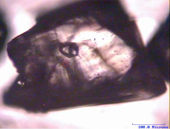 Coesite inclusion in zircon, North-East Greenland
Coesite inclusion in zircon, North-East Greenland
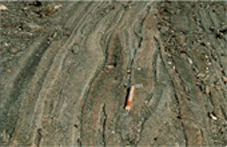 Folded UHP eclogites
Folded UHP eclogites
My research contributes to understanding the geodynamic processes of mountain building – from the microstructural level to the plate tectonic scale. As a skilled field geologist with a strong background in quantitative structural geology, metamorphic petrology, material science and tectonics, my main interests lie in studying ductile deformation of the crust in order to understand processes leading to the formation of mountain belts during continent-continent collision. One of the best natural laboratories for examining lower crustal deformation was created during the opening of the modern Atlantic Ocean, which exposed vast tracts of the deep roots of the Appalachian-Caledonian orogen. Thus, my fieldwork is primarily based in Sweden, Norway and Greenland. My research endeavors to integrate empirical observations with theory in order to address significant geodynamic problems.
HP and UHP terranes in the Greenland Caledonides
While mapping for the Geological Survey of Denmark and Greenland (GEUS) in the 1990s, I discovered a large eclogite province in North-East Greenland (Gilotti 1993, 1994), comparable in size to the famous Western Gneiss Region in Norway. The problem with this discovery is that the eclogites occur in the upper plate – not the downgoing slab – of the collision, raising the question of whether eclogites are forming at the base of Tibet today? Our work has addressed issues such as the PT of formation, geochemistry, timing, and regional setting of the Paleoproterozoic gneisses that contain the mafic eclogites. Coesite has been found in four samples on an island in the easternmost part of the eclogite terrane; UHP metamorphism is 350-365 Ma and marks the end of the collision (Gilotti et al. 2004, McClelland et al. 2006). Now we are worrying about how to produce UHP metamorphism in the overriding plate late in the collision (Gilotti and McClelland 2007).
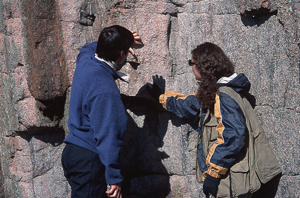
Gilotti and Sartini-Rideout discuss a vertical garnet lineation near Danmarkshavn, Greenland
Eclogite Exhumation
Exhumation of continental ultrahigh-pressure (UHP) terranes is one of the most enigmatic processes associated with UHP metamorphism for at least two reasons: 1. the structures that must have been active during the UHP and high pressure part of the decompression path are overprinted by lower grade structures and are very cryptic, and 2. Felsic crust subjected to UHP conditions should become denser than lithospheric mantle and sink. However, thin slivers of UHP continental crust are observed, and thus buoyant enough to be returned to Earth’s surface. Subduction channels provide a possible pathway back to the surface and are compatible with plate tectonic rates. Exhumation of the Greenland UHP terrane is especially problematic because of its upper plate setting and rates that are quite slow. Our current work is aimed at establishing the decompressional PTt path.
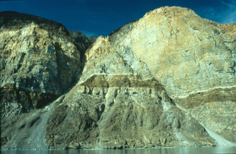 Upper plate of extensional fault system, East Greenland
Upper plate of extensional fault system, East Greenland
Regional Extension in the Greenland Caledonides
The southern half of the Greenland Caledonides records a complex history of crustal thickening and extension along low-angle ductile fault zones (Gilotti and McClelland 2008). Much of the extension is synorogenic and related to extrusion of middle and lower crust upward and laterally. Our current interests lie in studying how the low-angle extensional structures evolved into rifts that bound late Paleozoic to Mesozoic basins.
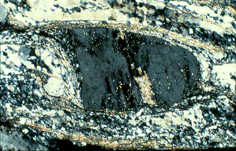 Sinistral sigma-type augen, Särv thrust sheet, Sweden
Sinistral sigma-type augen, Särv thrust sheet, SwedenMicrostructures in Metamorphic Tectonites
Observing microstructures in deformed and metamorphosed rocks is the starting point for understanding grain scale processes such as plastic flow, solid state recrystallization, growth or resorption of minerals, melting, and fluid-rock interactions - to name a few. Recently, my colleagues, students and I have used microstructures to study deformation mechanisms and kinematics of mylonite zones (Gilotti and McClelland 2005), recognize UHP metamorphism (Gilotti and Ravna 2002), understand prograde corona textures in eclogites (Sartini-Rideout et al. 2007) and document decompression melting of phengite at UHP conditions (Lang and Gilotti 2007). Microstructures are scientifically informative as well as aesthetically pleasing. In my former life at the New York State Geological Survey, Phil Whitney and I curated an exhibit for the New York State Museum called Splendor in Stone that showcases spectacular images of rocks viewed through the microscope.
Current Graduate Students
Megan Regel (PhD starting Fall 2013)
Sierra Isard (M.S. 2012 - in progress)
Arc or ocean? Origin of the Tower Peak assemblage, St Cyr area, Yukon-Tanana terrane, Canadian CordilleraWentao Cao (Ph.D. 2011 - in progress)
Aspects of UHP metamorphism in North-East Greenland Caledonides
Meredith Petrie (Ph.D. 2009 - in progress)
Tectonic implications of high-pressure rocks in the St. Cyr area, Yukon-Tanana terrane, Canadian Cordillera
2011 GSA Structural Geology and Tectonics Division Student Research Grant Award
Former Graduate Students and Post Docs
Thejashwini Ramarao (M.S. 2011)
Provenance of the Carboniferous basin in Holm Land: Implications for the Visean to Moscovian Tectonic HIstory of the North-East Greenland CaledonidesTimothy Nesheim (M.S. 2009)
Are 1.1 Ga deformational fabrics present in metasedimentary rocks of the Belt Supergroup, northern Idaho?
2008 GSA Structural Geology and Tectonics Division Student Research Grant AwardEmily Miller (M.S. 2008)
Exhumation of ultrahigh-pressure gneisses in North-East Greenland from titanite petrology and geochronologyClaudia Sartini-Rideout (Ph.D. 2006)
Petrological, strucural and geochronological study of eclogite facies rocks from the North-East Greenland CaledonidesSiobhán Power (Post Doc 2003-2005) now a Lecturer in Geology at Liverpool John Moores University
Recent Undergraduate Research Projects
Dylan Cook (2011-2012)
Laser Raman study of inclusions in zircon from the Yukon-Tanana terrane, Canadian Cordillera
Iowa Center for Research by Undergraduates Fellow 2011-2012Kelsey Karr (2011-2012)
Laser Raman study of inclusions in zircon from the NE Greenland UHP terrane
Nicholas Loper (2006)
Chemical Analysis of ultrahigh-pressure rocks in the Greenland Caledonides
Funded through an Iowa Research Experiences for Undergraduates award.Andrew Stolba (2006)
Exhumation of lower crust in East Greenland: a petrological and kinematic study of the Fjord Region detachment near Murgangsdal

